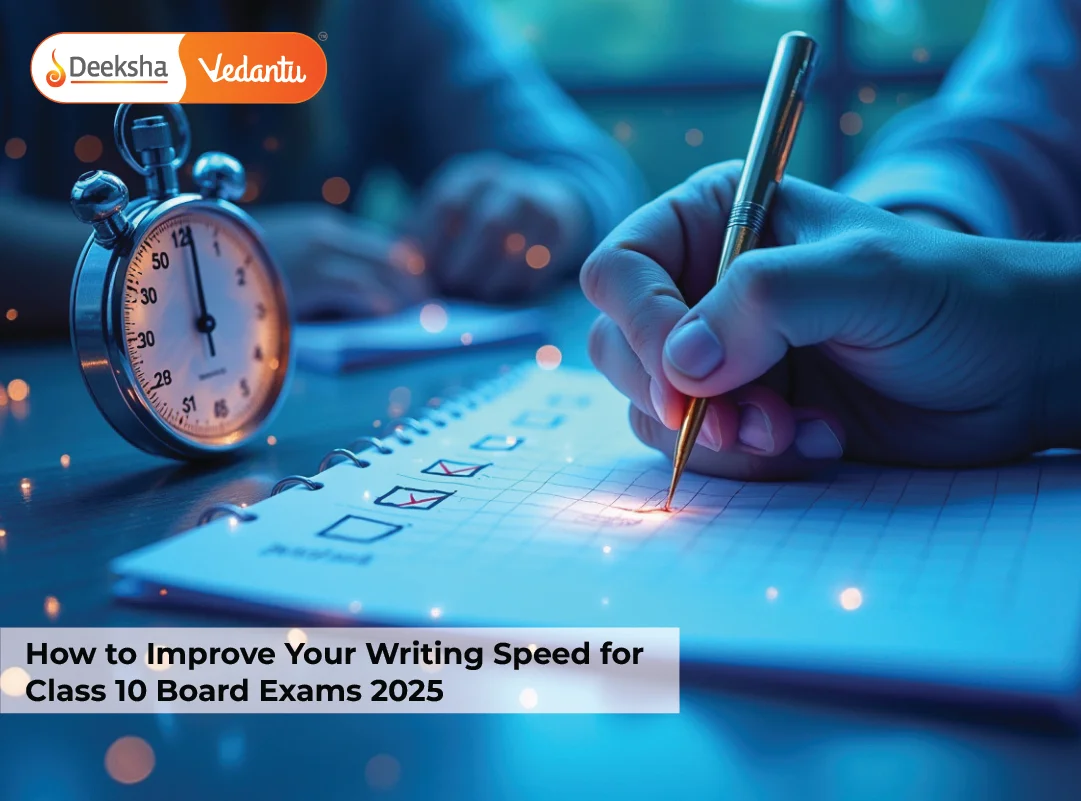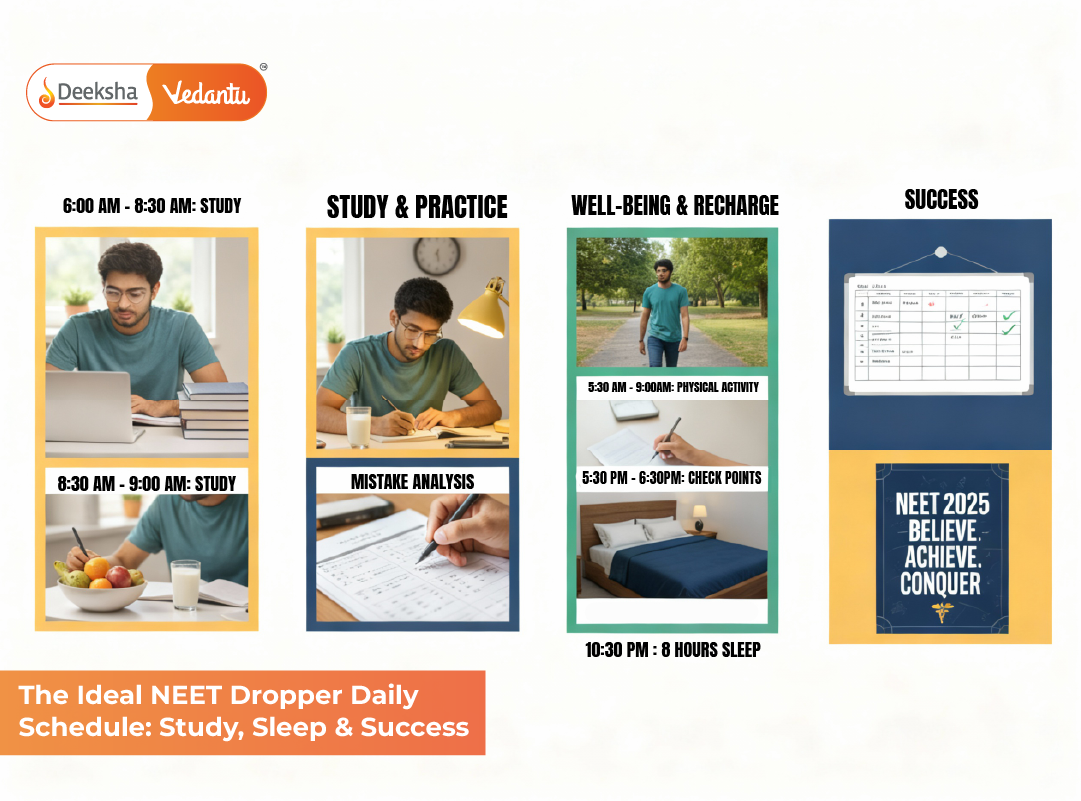Introduction
One of the biggest challenges students face in the Class 10 board exams is running out of time before completing their answers. Even students who know all the answers often struggle to finish the paper because their writing speed is too slow.
Common challenges students face:
✔ Slow handwriting—taking too long to write answers.
✔ Incomplete answers—leaving questions unanswered due to lack of time.
✔ Overthinking while writing—wasting time framing sentences.
✔ Messy handwriting—leading to lost marks due to illegibility.
Improving writing speed is not just about writing faster, but also about writing efficiently. By practicing the right writing techniques, time management strategies, and structured answer writing methods, students can increase their speed, clarity, and accuracy in the exam.
At Deeksha Vedantu, students receive expert guidance, time-bound writing practice, and structured coaching to help them master answer-writing speed and presentation for the Class 10 board exams.
7 Proven Techniques to Improve Writing Speed for Class 10 Board Exams
To complete all questions within the board exam time limit, students must train their hands and minds to write faster while maintaining legibility and accuracy. Here are seven proven techniques to improve writing speed for the Class 10 board exams.
1. Strengthen Hand Muscles & Improve Handwriting Speed
Writing for long hours can cause hand fatigue, slowing down writing speed. Strengthening hand muscles through regular writing practice and grip improvement can help students write faster with less strain.
How to Improve Handwriting Speed:
✔ Use a comfortable pen that allows smooth, effortless writing.
✔ Hold the pen correctly—avoid gripping too hard or too loose.
✔ Do handwriting drills such as writing alphabets, numbers, and words continuously for 5 minutes.
✔ Practice freehand writing exercises to increase fluency.
Example:
- Write the same paragraph three times, timing yourself each time.
- Focus on maintaining speed without compromising legibility.
Tip: Use a gel pen or rollerball pen for smoother and faster writing compared to ballpoint pens.
2. Set Writing Time Targets & Speed-Building Exercises
The best way to improve writing speed is through timed writing practice.
How to Build Writing Speed:
✔ Set a goal to write 100-150 words per 5 minutes.
✔ Time yourself while writing long answers and essays.
✔ Gradually reduce the time for writing answers without affecting clarity.
Example:
- Write one-page answers under strict time conditions (e.g., finish within 10 minutes).
- Compare speed weekly and analyze improvement.
Tip: If you find yourself pausing frequently while writing, train your mind to think ahead before starting each sentence.
3. Master the Art of Concise & Structured Answer Writing
A structured approach helps students write faster and more effectively without unnecessary explanations.
How to Write Concisely:
✔ Follow the Introduction – Body – Conclusion format for essays.
✔ Use bullet points for factual answers to save time.
✔ Underline key points, formulas, and important terms to make the answer stand out.
Example:
Bad Answer: “The photosynthesis process is when plants take in carbon dioxide and water from their surroundings. They use sunlight to convert these elements into glucose and oxygen, which is released back into the environment.”
Good Answer:
Photosynthesis Process:
✔ Reactants: CO₂ + H₂O + Sunlight → Glucose + O₂
✔ Occurs in: Chloroplasts of green plants
✔ Importance: Produces oxygen and food for plants
Tip: Avoid long, unnecessary explanations—write to the point!
4. Use Abbreviations & Symbols for Faster Note-Taking
Students can save time in subjects like Science and Social Studies by using shorthand methods, abbreviations, and symbols instead of writing full words.
How to Use Abbreviations & Symbols:
✔ Use arrows (→) instead of writing ‘leads to’ or ‘results in’.
✔ Use Mathematical symbols (∑, %, ≠, ∞) instead of writing words.
✔ Abbreviate long words:
- Govt. (Government)
- WWII (World War II)
- H₂O (Water)
Example:
Instead of writing “Water evaporates due to heat, forming water vapor, which rises and later condenses to form clouds,”
Write: “H₂O → (heat) Vapor ↑ → Clouds (Condensation)”
Tip: Make your own list of commonly used abbreviations for quick writing!
5. Improve Mental Processing Speed for Faster Writing
Many students waste time thinking about what to write, slowing down their writing speed. Improving mental processing speed can help students frame answers quickly.
How to Think & Write Faster:
✔ Read questions twice and break them into key parts.
✔ Plan answers mentally before writing—avoid stopping mid-sentence.
✔ Think of keywords first, then expand them into full sentences.
Example:
- Instead of pausing while writing an essay, mentally outline the structure:
- Introduction (Define the topic)
- Body (Main arguments, key facts, examples)
- Conclusion (Final summary)
Tip: While practicing, set a 10-second limit to frame an answer in your mind before writing it down.
6. Practice Previous Year Papers Under Timed Conditions
Practicing past papers under exam-like conditions is the best way to develop writing speed, time management, and confidence.
How to Use Previous Year Papers Effectively:
✔ Set a timer and complete full-length answer papers within 3 hours.
✔ Analyze which sections take the most time and adjust writing strategies.
✔ Learn to quickly transition between different question types.
Example:
- If theory-based questions take too long, practice writing shorter, more direct answers.
- If you struggle with diagram-based questions, practice drawing neat, labeled sketches faster.
Tip: Use a stopwatch during every writing practice session to develop speed and accuracy simultaneously.
7. Train with Mock Tests & Handwriting Speed Tests
Regular mock tests build stamina, improve answer structuring, and increase writing speed.
How to Train with Mock Tests:
✔ Write a full-length mock test weekly.
✔ Track progress by timing each section and adjusting speed accordingly.
✔ Get feedback from teachers to improve presentation and clarity.
Example:
- A student struggling with long-answer writing can focus on reducing unnecessary words and structuring answers better.
Tip: If you finish a test early, use the extra time to review and improve handwriting where needed.
How Deeksha Vedantu Helps Students Improve Writing Speed
At Deeksha Vedantu, students don’t just learn concepts—they master efficient exam strategies, including writing speed enhancement techniques. Here’s how Deeksha Vedantu’s expert guidance ensures students write faster, complete their exams on time, and improve answer presentation.
1. Time-Bound Practice Sessions to Build Speed & Endurance
✔ Regular timed writing drills train students to complete answers within board exam time limits.
✔ Speed-based tests help students improve handwriting fluency while maintaining accuracy.
✔ Weekly full-length mock exams simulate real exam conditions, helping students develop writing stamina.
Example:
- A student struggling with long-answer writing speed is given a structured writing schedule with progressively tighter time limits to improve fluency.
Tip: Deeksha Vedantu’s time-bound tests help students avoid last-minute rushing and incomplete answers.
2. Expert Guidance on Structured Answer Writing Techniques
✔ Teachers train students in the best answer formats for different question types (long answers, short answers, definitions, and numerical problems).
✔ Emphasis on stepwise presentation to maximize marks while maintaining speed.
✔ Students learn to highlight key points and underline important terms to make answers examiner-friendly.
Example:
- If a student takes too long writing Science definitions, Deeksha Vedantu mentors train them in keyword-based structuring to make answers concise yet effective.
Tip: Writing in bullet points rather than lengthy paragraphs saves time and improves clarity.
3. Personalized Mentoring & Handwriting Analysis
✔ One-on-one mentoring sessions for students needing extra guidance on writing speed.
✔ Handwriting clarity analysis—students receive feedback on improving letter formation, spacing, and speed.
✔ Customized speed-building exercises based on individual student needs.
Example:
- A student with slow writing due to unclear handwriting is given specific exercises to improve pen grip, letter spacing, and writing fluidity.
Tip: Deeksha Vedantu’s personalized mentoring ensures that students get tailored support in improving speed without losing readability.
4. Smart Revision Strategies & Formula Retention Techniques
✔ Flashcards, mind maps, and visual aids are used to reduce dependency on long written explanations.
✔ Fast note-taking techniques help students summarize large portions of information in a structured, time-efficient manner.
✔ Handwriting drills combined with mock test reviews allow students to continuously refine their writing style.
Example:
- Instead of writing long paragraph-based Social Science answers, students learn to structure responses using short, impactful points—saving time while scoring full marks.
Tip: Deeksha Vedantu’s fast revision techniques ensure students spend less time writing and more time thinking strategically during exams.
FAQs on Writing Speed Improvement for Board Exams
1. How much time should I practice writing daily to improve my speed?
✔ Ideally, students should practice writing for at least 30-45 minutes daily.
✔ Start with short timed exercises (5-10 minutes) and gradually increase duration.
✔ Focus on both speed and clarity—writing fast but illegible won’t help in exams.
🔹 Example:
- Write a 250-word answer in 10 minutes and try to reduce the time gradually while maintaining legibility.
2. What type of pen is best for fast writing in board exams?
✔ Choose a lightweight gel pen or rollerball pen for smooth, fast writing.
✔ Avoid heavy, slow-drying pens that require extra effort to move across the paper.
✔ Test different pens before exams to find one that offers speed and comfort.
🔹 Example:
- Best options: Uniball, Pilot V5 RT (gel), and Cello Butterflow (ballpoint).
3. How can I complete my exam on time without rushing?
✔ Follow a time management strategy:
- 1-mark & 2-mark questions: Complete in 30 minutes.
- 3-mark & 5-mark questions: Allocate 1.5 hours.
- Final 15 minutes: Revise and recheck answers.
✔ Write in a structured format—avoid long, unorganized paragraphs.
✔ Underline key points and box final answers to make evaluation easier.
🔹 Example:
- In Mathematics, avoid wasting time erasing and rewriting answers—use logical steps to proceed efficiently.
4. Does improving handwriting help with writing speed?
✔ Yes! Clear, legible handwriting helps students write faster with minimal effort.
✔ Students with untidy handwriting often waste time rewriting answers, reducing their speed.
✔ Writing fluently and neatly ensures that examiners can easily read and award marks.
🔹 Example:
- Practice writing 10 lines daily in neat, cursive handwriting to develop fluency.
5. How does Deeksha Vedantu’s approach help students write faster in board exams?
✔ Time-bound writing exercises help students complete answers within exam duration.
✔ Handwriting speed tests & mentor feedback ensure students write clearly and efficiently.
✔ Mock exams under real-time conditions train students to think and write quickly.
🔹 Example:
- If a student struggles with slow answer writing, Deeksha Vedantu trains them in summarization techniques and structured response formats to boost speed.
Conclusion
Writing speed plays a critical role in achieving high scores in the Class 10 board exams. Even the most well-prepared students can lose marks if they fail to complete their answers on time. By following structured techniques, timed writing exercises, and smart answer presentation methods, students can write faster while maintaining accuracy and clarity.
✔ Strengthening hand muscles and improving handwriting fluency reduces strain and increases speed.
✔ Timed writing practice and previous year paper-solving help students develop the ability to complete their exams within the allotted time.
✔ Concise, structured answers using bullet points, underlined key points, and stepwise solutions improve both speed and readability.
✔ Deeksha Vedantu’s expert training provides time management techniques, mentor-guided feedback, and mock test simulations, ensuring students develop the skills needed to write efficiently in board exams.
With consistent effort, smart techniques, and Deeksha Vedantu’s expert guidance, students can master writing speed and confidently ace their Class 10 board exams!
Table of Contents










Get Social